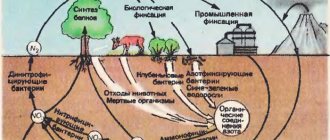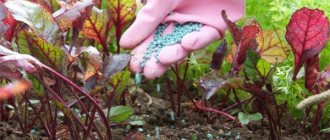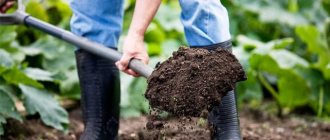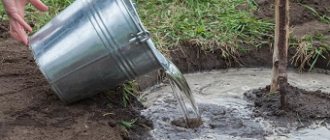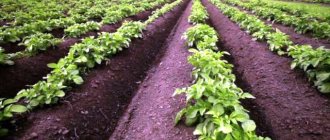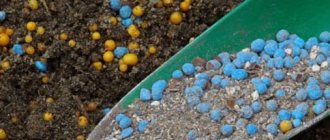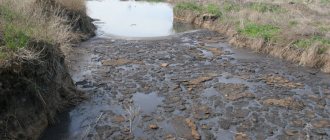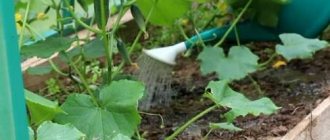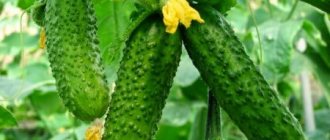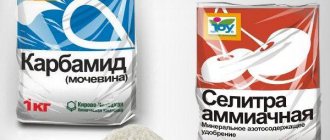The role of nitrogen in growing cucumbers
The main substance that plants need is nitrogen. Thanks to it, cucumbers receive nutrients at all stages of development. This promotes rapid growth of green mass. The vines grow well and large leaves form on them. The flowers that set do not fall off, which allows you to set a lot of ovaries and get a high yield. Under natural conditions, nitrogen is located in humus (top layer of soil).
Under the influence of various microorganisms, nutrients become available for absorption by the plant. If a lot of fruit-bearing crops are planted on the site, then the natural reserves of micro- and macroelements are not enough. In this case, gardeners resort to nitrogen fertilizers for cucumbers.
Attention!
A sign that plants lack nitrogen is a small volume of leaf mass, stunted growth and elongation of the tops, and this is clearly visible in the photo.
But if the soil is regularly fertilized, but the cucumbers still do not grow, then the reason for this lies in unsuitable or completely depleted soil. If the soil has a high pH level or the seeds were planted in cold, unheated soil, the nitrogen will be in a form that is not available for absorption by plants.
In this case, fertilize the cucumbers with nitrate nitrogen (sodium nitrate or ammonium nitrate). At slightly alkaline and neutral pH levels, ammonium sulfate and ammonium nitrate are used.
Why do plants need nitrogen?
Since nitrogen is the main element involved in the metabolism of animal and plant cells. It is a component of almost all parts of the cytoplasm of a plant cell, its proteins, chlorophyll, most vitamins, nucleic acids, and enzymes.
What are the consequences of low nitrogen content in the soil?
It is known that plants take everything they need for their nutrition, growth and development from the soil. If there is a nitrogen deficiency in the soil, then the plants develop poorly: the stems and leaves are thin, flaccid, quickly turn yellow, a small number of ovaries are formed, which do not bear fruit or bear fruit poorly. As a result, the plants quickly die.
Signs of nitrogen deficiency in cucumbers and danger to the crop
In the gaseous state, nitrogen is found in the atmosphere and its quantity is unlimited. A number of cultivated plants can convert this substance into an assimilable form. These include, for example, legumes. Cucumbers do not have this ability, so they need nutrition through the soil and leaves.
The main signs of nitrogen deficiency:
- blanching of foliage and fruits;
- formation of a beak-like process in the area where the flower is located;
- yellowing of foliage at the bottom of the shoots;
- cessation of growth and development of lateral lashes.
If you do not feed plants with nitrogen, they will produce a low yield or may die completely before flowering, and will be very sick beforehand. Vegetable crops react acutely to a lack of minerals in the soil. If one or more signs are detected, organic or mineral fertilizer must be applied.
How to feed cucumbers
Cucumbers are easy to grow. The plant is tall, grows quickly, and abundantly increases its vegetative mass. you should not plant seedlings in open ground or greenhouses too early . In the southern regions, the crop is sown directly in open ground (seedless cultivation method).
The tropical vegetable loves moisture, fertile soil, light and warmth . It is grown all over the world, with the leading producing countries being China, Russia and Turkey.
Features of seasonal feeding
The nutritional preferences of cucumbers differ significantly from the needs of other vegetables and root vegetables.
Important: cucumber, unlike tomatoes, is especially sensitive to the presence of organic matter in the soil; the crop grows poorly in poor soils .
Despite the fact that the vegetable produces a voluminous, powerful vegetative mass, it is less demanding of nitrogen nutrition than tomatoes.
Most nitrogen fertilizers are applied at the very beginning of growth. Potassium is a key nutritional element and is added throughout the growing season.
In addition, the crop loves calcium and magnesium ; fertilizing is applied in the same amount as nitrogen fertilizers. In autumn or early spring, during the main filling of the soil for cucumbers, the soil is limed and dolomite flour or ash is added.
Organic matter (rotted manure, compost, bird droppings) is added to the planting holes immediately before planting or sowing. When planting late, green manure, nettles, and weeds are placed in the holes.
Classification of nitrogen fertilizers
Fertilizers for cucumbers are classified according to the form of nitrogen. They are divided into 5 main groups, the difference in which is the level of concentration of the substance.
| Form | Characteristic | Representative |
| Nitrate | The composition contains nitrogen in the form of nitrate NO3 | Sodium nitrate Calcium nitrate |
| Ammonium | The composition contains nitrogen in the form of ammonium NH4+ | Ammonium nitrate Calcium ammonium nitrate |
| Ammonium nitrate | The composition contains nitrogen of two compounds (ammonium + nitrate) | Ammonium sulfate Sodium ammonium sulfate Ammonium chloride |
| Amide | The composition contains nitrogen in the form of NH2- | Urea Calcium cynamide |
| Ammonia | Contains liquid form of ammonia NH3 | Anhydrous ammonia Ammonia water Ammonia Carbamide-ammonium nitrate |
Slow-acting forms are also distinguished. These include: urea-formaldehyde, encapsulated fertilizers, nitrification inhibitors.
How to apply fertilizers correctly
If there is a nitrogen deficiency in planted cucumbers, nitrogen fertilizers must be added to the soil every 10 days or 2 weeks. 20 days before harvesting vegetables, you should stop fertilizing.
Attention!
Any composition must be used clearly, as required by the instructions. Only in this case will they benefit the plants.
The most effective way of feeding is considered to be spraying urea on the leaves, so the plant will quickly absorb the beneficial substances included in its composition. To prepare the working solution, take 5 tbsp. and diluted in 10 liters of water. The procedure is carried out early in the morning on a cloudy day. When fertilizing cucumbers with ammonium nitrate, care must be taken. It must be applied to the soil to a depth of 10 cm.
It is recommended to apply calcium nitrate right before sowing the seed, after which rapid germination will occur. Then the plant is fertilized with it throughout the growing season. Spraying with calcium nitrate will help prevent root rot and protect against ticks and slugs.
Types of nitrogen fertilizers
When the soil is depleted, fertilizers must be applied, which allows you to saturate the soil with nutrients and get a good harvest. Nitrogen additives come in solid and liquid forms. Gardeners most often use liquid fertilizers. The consumption is economical and the application is convenient. The main component of these additives is ammonia.
How nitrogen is useful for cucumbers
Cucumbers at different stages of development require nitrogen, but in optimal quantities. The element can help vegetable crops:
- grow leaves, stems;
- begin to bloom;
- form ovaries and fruits;
- bear fruit for a long time.
Since nitrogen compounds are found in garden soil, its upper layer, the roots of cucumbers absorb them normally. But over time, the soil becomes depleted, then fertilizing containing nitrogen is needed. The substance is poorly absorbed by the roots of the vegetable if the temperature drops. It is difficult to absorb nitrogen from soil with high acidity. Therefore, it is necessary to fertilize correctly so that the cucumber receives sufficient nutrition.
Terms and rules for applying fertilizing
To get maximum efficiency from fertilizing and not make the crop unfit for consumption, you need to adhere to the deadlines. They directly depend on the variety of vegetable crop, as well as the agricultural technology used during planting. If there is an excess or lack of mineral fertilizers in the soil, the opposite effect is created - negative.
In the autumn, when the soil is being prepared for future planting of cucumbers before the onset of winter, it is recommended to enrich it with organic fertilizers. Over the next six months, the soil will gradually receive released microcomponents. Preference should be given to manure, humus and chicken droppings.
Signs of deficiency and excess of nitrogen in the soil
Nitrogen deficiency is most typical for podzolic and sandy soils. This can be judged by the inhibition of plant growth. The foliage turns pale, few shoots, leaves and flowers are formed on the bushes. Another sure sign is the location of the leaves at an acute angle. The tops gradually become thinner and turn yellow. Initially, a yellow tint becomes noticeable on the veins of the lower leaves, and later the entire foliage turns yellow. The shape of cucumbers changes - they become sharper towards the bottom and decrease in diameter.
Excess nitrogen in the soil also occurs and does not bring anything good to cucumbers. Its main manifestation is the accelerated growth of bushes. The stem and leaves thicken and acquire a rich, dark green color. Male flowers begin to predominate, which causes poor fruiting.
Fertilizing
The timing of fertilizing cucumbers in the spring also depends on agricultural technology. When planting a vegetable crop, the method of fertilizing the holes is used. To do this, mix straw and rotted humus or manure in equal proportions. Then they spread the mass on the bottom of the hole and cover it with a layer of earth on top. This will prevent direct contact of the roots with the fertilizer, and they will not “burn.”
Liquid fertilizers are recommended to be applied approximately 2 weeks before planting. You can take a glass of wood water and dilute it in 10 liters of water, or in the same amount of liquid 20 g of urea, 30 g of superphosphate and 10 g of potassium chloride. 500 ml of fertilizer is enough for each hole, but you can distribute the entire volume evenly throughout the bed.
During the flowering period
Approximately 10 days after the first fertilizing, which coincides with the beginning of flowering, the cucumbers are fertilized again.
You can prepare the following fertilizer at home:
- ammonium nitrate – 10 g;
- superphosphate – 15 g;
- potassium salt – 15 g;
- water – 10 l.
If desired, you can use ready-made complex fertilizers, which are sold in specialized stores.
During the fruiting period
In another 10 days the fruiting period will begin. At this time, you need to apply fertilizing again according to the same recipe. Approximately 2 weeks before harvesting, stop fertilizing the soil with mineral and organic compounds. This will prevent the accumulation of nitrates in cucumbers and guarantee the environmental friendliness of the product.
Types of fertilizers
Along with the mandatory mineral fertilizers (nitrogen-phosphorus-potassium), cucumbers need complex mineral supplements of micro- and macroelements - calcium, boron, zinc, magnesium, etc.
Organic fertilizers, bioadditives, liquid composts, manure fertilize and structure the soil. But completely replacing the necessary “diet” with organic matter without adding essential minerals is problematic.
Mineral
Basic ratio of NPK components for cucumber:
- 1 part nitrogen
- 2 parts phosphorus,
- 3 parts potassium.
Complex fertilizers for cucumbers:
- Fertilizer for zucchini and cucumbers “Clean Leaf” , 100 g and 300 g, vitamin and mineral complex is used for irrigation (including drip), sprinkling and spraying;
- “Master-Agro” for squash, zucchini and cucumbers, 50 ml, a product based on phytohormones, basic minerals (ratio 22:8:16), microelements, amino acids and vitamins;
- “Helatin Cucumber” , 50 ml, water-soluble complex preparation, optimizes metabolic processes, prevents the withering and falling of buds, flowers and ovaries.
Nitrogen fertilizers for cucumbers:
- Urea (urea, contains more than 40% nitrogen), soluble crystals, 30 g per 1 garden bucket is enough, used 2 weeks after planting seedlings.
- Ammonium nitrate (nitrate fertilizer), granules contain 30-34% nitrogen, are used at the time of pre-sowing preparation and in the early stages of growth as root nutrition (stimulates the development of the vegetative part).
Phosphorus fertilizers:
- Superphosphate is the simplest phosphorus fertilizer, strengthens the root system, affects the processes of oxidation, photosynthesis and respiration; applied during spring soil preparation, used in tank mixtures with potassium and nitrogen fertilizers;
- Phosphorite flour is used as a basic soil fertilizer and for preparing compost; applied in spring or autumn;
- Borofos or borofoska is a universal balanced complex of minerals and trace elements, contains 10% phosphorus, up to 20% calcium and potassium, an effective preparation for strengthening the roots of vegetable seedlings, a soft (gentle) soil deoxidizer.
Potash fertilizers for cucumbers:
- Potassium sulfate (more than 50% potassium), contains magnesium and sulfur; normalizes protein and carbohydrate metabolism; prevents putrefactive processes, is absorbed by all garden plants;
- Potassium monophosphate , granules contain more than 30% potassium and up to 53% phosphorus; provides energy and metabolic processes; used for severe phosphorus deficiency; as a supplement it is safe throughout the season;
- Chelatin potassium , a concentrated preparation, provides rapid access of potassium to the roots and leaves.
Organic
To improve soil fertility in the fall or during spring digging (on light sandy and sandy loam soils), organic matter is added to the cucumbers:
- rotted manure;
- compost;
- bird droppings.
You should not get carried away with diluted solutions of manure and droppings, especially in June-July.
Excess nitrogen results in excessive uncontrolled growth of the above-ground parts. Green fertilizers are a natural source of nitrogen, microelements and vitamins. Liquid composts (herbal infusions and fermenters) are easy to prepare. Suitable base raw materials:
- any weeds (sow thistle, wood lice);
- nettle, sweet clover, vegetable physalis;
- green manure (lupine, rye, phacelia).
The method for preparing herbal fermentation for cucumbers is simple:
- finely chop raw materials;
- in a technical container (barrel, bucket) tightly place the herbal “salad” to 2/3 of the container’s volume;
- to activate fermentation, add 1-2 kg of manure;
- fill the container to the very edge, stir the thicket;
- the barrel is placed in a remote sunny place;
- pre-close tightly with a transparent film or lid;
- The infusion is ventilated daily for 15-20 minutes;
- after 5-6 days the walker is ready;
- It is important to use the contents within 2 weeks (while butyric acid is released from the decomposed herbs).
The extract is used for foliar and root nutrition in the following ratio:
- for spraying - 100-150 ml of mother solution is diluted in 8-9 liters of water;
- watering dose - 1 liter of extract to 10 liters of water, for each bush - up to 1 liter of diluted working solution.
Gardener tips:
- To replenish potassium reserves, add 1 tbsp to the green fermentation solution. l. potassium sulfate per 10 liters of working solution.
- The fixative drugs Azotovit, stimulant Gulliver, Kalivit, Phosphatovit are well combined with herbal infusions.
- Azovit and Gulliver preserve the fermenter and turn the infusion into a biological product. The shelf life of the infusion increases to 5-6 months.
- You should not add alkaline solutions, such as ash, to country cocktails. Beneficial ammonia evaporates, and when watering, methanogenic bacteria are activated.
- It is useless to combine herbal fermenters with Fitosporin. Bacillus subtilis bacteria do not take root in herbal infusions.
Features of feeding cucumbers with nitrogen
Fertilizing for seedlings is applied in doses. If the deadlines or recommendations regarding concentration are not followed, there is a possibility that the plant will die. If cucumbers are oversaturated with fertilizers, they accumulate nitrates, and subsequently fruits of irregular, ugly shape develop.
In a greenhouse (greenhouse)
You may be interested in: Favorable days for transplanting cucumbers in open ground Dates for planting cucumbers in May 2021 according to the lunar calendar The most favorable days for planting cucumbers in the Leningrad region according to the calendar of gardeners and gardeners
The use of fertilizers for cucumbers in a greenhouse or greenhouse is possible only during the period of preparing the soil for planting seeds. Approximately 14 days before the planned planting date, the soil is fed with urea in combination with phosphorus or potassium fertilizers.
For the solution take:
- urea – 15 g;
- superphosphate – 30 g;
- potassium sulfate – 20 g.
The prepared volume of the mixture is sufficient to treat 1 m2 of soil. When the seedlings have strengthened, perform the first root feeding with urea. After this, you can fertilize the plants 2 times a month until the period of fruit formation begins.
In the open ground
Experienced gardeners know that cucumbers are among those plants that love water, so they have to be watered often. They do this every day, or every other day, early in the morning or before sunset. During the period of fruit formation, watering should be as intense as possible, otherwise the cucumbers will be bitter.
You can feed the plant with liquid fertilizers, for example, bird droppings, ash and water. The solution is made according to the following recipe:
- take a container of any volume and fill 1/3 of it with manure or bird droppings;
- then add water and mix thoroughly until smooth;
- Before use, dilute manure with water in a ratio of 1:2, and bird droppings in a ratio of 1:3.
10 days after the first shoots hatch, root feeding is done. It is continued at intervals of 10-14 days until the cucumbers begin to bear fruit.
Fertilizer recipes for cucumbers
It is necessary to control the temperature regime, soil fertility, acidity level and nutrient supply in open plantings, and in tunnels (greenhouses), and greenhouses. We will tell you in more detail about some of the nuances of growing cucumbers.
Feeding cucumbers in open ground
In cold regions, cucumbers are not planted in open areas. The crop does not like temperature swings, and the productivity of the plant decreases. It is difficult to control nighttime temperature changes in open ridges; additional shelter is required.
Bee-pollinated traditional varieties are most often planted in open ground :
- Elegant;
- fontanel;
- Chinese kite;
- Competitor, etc.
The fruits of these varieties are considered more tasty and juicy, and yields are on average higher.
Folk remedies
There are many methods of feeding cucumbers that have been used for centuries. These are the so-called folk methods:
- feeding with ash is perhaps the simplest of all. You just need to dilute 2 cups of ash in 10 liters of warm water. Water a liter jar under each root;
- onion peel infusion - pour 0.15-0.2 kg of onion peel with a bucket of hot water (≈90°C), let it sit until it cools, about 4 hours. You can water a liter under each root, you can spray the foliage;
- Yeast fertilizer is the most effective fertilizer that can be prepared at home. Dissolve 1 small pack of yeast in 3 liters of warm water, add a little more than half a glass of sugar and leave in a warm place for 3 days, remembering to stir. Add 1 glass of this solution to a bucket of water and pour a half-liter jar under each bush. This fertilizer is also suitable for spraying, just strain it before use so as not to clog the spray bottle.
If there is no yeast, prepare bread feeding for cucumbers: fill a third of the bucket with pieces of bread, add water and leave until the bread ferments. Strain. The bread can be placed in a compost pit, and 2 liters of bread infusion can be added to a bucket of water for watering the cucumbers.
Greenhouse activities
Greenhouse plants require more nutritional supplements than those grown outdoors. The reason is the lack of useful elements that could get with rainwater, as well as the lack of pollination in a closed space. When choosing fertilizers for cucumbers at home, it is important not to get carried away, since an overdose is harmful to greenhouse plants. Often, to feed cucumbers, summer residents use only organic matter in greenhouses - bird droppings and mullein, and also add yeast, dairy products and herbal infusions.
Cucumber seedlings are grown from seeds. The process includes a number of activities:
- long warm-up;
- hydration;
- complex fertilizer;
- cooling and placing seeds in pots.
For about a month, the seeds for seedlings are kept in a warm room where the temperature is maintained at 25°C. This way it is possible to speed up future fruiting, ensure uniform shoots and reduce the amount of barren flowers. Before germination, the grains are placed for an hour in a solution of 30 g of garlic pulp and 100 ml of water to disinfect. Next, they are placed on a piece of fabric soaked in a nutrient solution (for 1 tablespoon of water, take 1 teaspoon of ash and nitrophoska). When the grains swell in a humid environment and slightly hatch, they are placed in the refrigerator for a day to harden.
A mixture of rotted sawdust, humus and peat is poured into each pot in a ratio of 1:2:2. This mixture is fertilized with 2 tbsp. ash and 1.5 tbsp. nitrophoska. Place 1 seed in a pot with a nutrient mixture. Do not forget to water the seedlings at least once a week. Be sure to provide lighting.
The seedlings are transplanted into the greenhouse when 4–5 leaves appear on the stems. This moment occurs approximately 3 weeks after planting the seeds. Before transplanting, each sprout is fertilized (3 tsp of nitrophoska or nitroammophoska per 3 liters of water). The shoots are planted in warm soil, previously watered with a pale pink solution of potassium permanganate and sprinkled with 1 tsp. phosphate fertilizer. The interval between two adjacent seedlings is 35 cm.
What fertilizers do cucumbers need?
Cucumber beds consume: nitrogen, phosphorus, potassium and iron with magnesium. The basis of cucumber nutrition is the NPK complex (nitrogen + phosphorus + potassium).
Each square meter of cucumber beds draws the following amount of microelements from the soil:
- Nitrogen – 15 (g/m2)
- Phosphorus – 20 (g/m2)
- Potassium – 20 (g/m2)
- Magnesium – 5 (g/m2)
How to use fertilizers? – Of course, this is an approximate average figure. Experienced summer residents are guided by the above data, but the volume of fertilizers is subject to adjustment. That is, by the color of the leaves and the shape of the cucumbers, you can determine what exactly the beds lack and what is used in excess.
Organic
Our ancestors fertilized their gardens only with organic substances, since they did not know about chemicals in those days. However, the fertile layer of the earth has been depleted over many centuries of cultivation, so it is necessary to compensate for the lack of microelements with agrochemists. But the use of organic mixtures has not lost its importance; they are still used in garden plots.
Ash
Wood ash contains a lot of phosphorus compounds and potassium, but no nitrogen. Organics are used throughout the summer season in any form: dry, diluted. Feeding cucumbers with ash begins with placing the seedlings in the holes. The ash is sifted and mixed with soil: half a cup of ash is used for one hole.
In the future, several methods of adding ash are used:
- ash solution: take a glass of ash per liter of liquid;
- pour a couple of glasses of dry ash under the bush, then water it generously;
- sprinkle ash powder on leaves and vines of cucumbers before watering.
The ash contains many phosphorus compounds, without which the development of seedlings slows down. This microelement affects the formation of the root system, ovaries, and fruits. The taste characteristics of cucumbers largely depend on the sufficient phosphorus content in the soil.
Litter
This is the most ancient fertilizer of all. Animal and bird droppings are used in gardening. This substance quickly saturates the soil with microelements and is well absorbed by plants. During the summer season, manure is added in liquid fermented form: fresh manure has a negative effect on the root system and can cause burns. To get mullein, 2 buckets of freshly collected manure are filled with warm water (bucket). This mixture is covered and placed in a warm place for fermentation (preferably in a sunny place in the garden).
When the mixture has fermented, it is used for root watering. You need to add a liter of mullein to a bucket of water. A couple of liters of diluted organic matter are used for one cucumber bush.
You can prepare the mixture according to a different recipe. To do this, fresh manure (a bucket) is mixed with water (4 buckets) and placed in the sun. You need to stir the infusion periodically so that it ferments faster. For irrigation, prepare the following solution: a bucket of mullein is diluted in ten buckets of water. 2 liters of solution are consumed per bush. Gardeners water cucumbers with this mixture every two weeks, and they can also be used for spraying.
Green manure
This is also an ancient method of enriching the soil with microelements. An infusion or decoction is prepared from weeds (without seeds). To make an infusion, the cut weeds are placed in a barrel to a third of its volume. Then fill it with rain or settled water and leave it to rot for 10 days. It is advisable to place the barrel or other container in the sun. When the herb is infused, a liter of infusion is diluted in a bucket of water for irrigation. The infusion is applied under the root or grooves are made.
A decoction of weeds is made as follows: the cut greens are steamed with boiling water and left wrapped to cool. The resulting solution does not need to be diluted with water. A liter of the nutrient mixture is applied under each cucumber bush. Fertilize once a week.
Eggshell
The shell is used to alkalize acidic soil and feed plants. It also helps loosen the soil. Dried shells are used, which are first crushed to a powder state. The powder from five eggs is dissolved in a liter of water (boiling water), left to infuse for 5 days. Then dilute with water in a ratio of 1:5 and water using the root method.
Gardeners like to use the following composition of waste for feeding:
- carrot tops;
- banana peel;
- potato peelings;
- fruit waste.
The mixture is poured with boiling water and left to ferment for a week. Then five liters of water are added to the strained mixture (250 ml). All this is combined with the liquid from the shell (1:1).
Onion peel
Dried skin is a source of nutritional components necessary for the development of seedlings. The infusion also contains bactericidal substances that will protect seedlings and mature plants from attack by fungal and other harmful microorganisms.
Recipe for husk infusion:
- 20 g husk;
- 5 liters of liquid.
Leave the infusion in a warm room to ferment for 5 days, then filter and spray the cucumber beds leaf by leaf.
Recipe for husk decoction:
- boiling water - 1.5 l;
- husk - a handful.
Pour boiling water over the husks and cook over low heat for about 7 minutes. Leave to cool, then strain. The result is a concentrated solution, which must be diluted with water (3.5 liters) before watering. Used for root irrigation, as well as for leaf irrigation.
Fertilizer application stages
Compliance with the fertilizing schedule is the key to success. Each fertilizer is characterized by the rate and frequency of use. More than once we have emphasized that everything should be in moderation and that fertilizers should not be used in excessive quantities.
Taking into account the experience of vegetable growers, we can conclude that fertilizers should be applied in this order.
First stage
made two weeks after planting. Both organic matter and mineral additives can be used as fertilizer. You can fertilize:
- fresh chicken droppings. Prepare a solution in a ratio of 1:15;
- slurry. Concentration 1:8;
- cow or horse manure. This infusion is more concentrated. For 1 kg of manure you need to take 6 liters of warm water;
- infusion of green herbs;
- urea;
- superphosphates;
- ammonium nitrate;
- potassium salt;
- ammophos.
Second phase
Fertilization begins during the flowering period. Feeding should be foliar. It is permissible to use only an infusion of green grass as organic matter. Mineral supplements include potassium and ammonium nitrate and superphosphates.
Third stage
begins during the period when fruits appear on the bushes. This kind of foliar feeding. It is acceptable to use herbal infusion. Mineral fertilizers can be used potassium nitrate, urea and ash.
The last, fourth feeding,
necessary in order to extend the fruiting period. It is recommended to use an infusion of rotted hay, which has been infused for two days, as well as urea and baking soda.
The amount of fertilizing and the type of fertilizer can be adjusted. If you see that the cucumber bushes look healthy, they are bright green, the growing season is going well, you should not fill them with fertilizers. Reduce the number of feedings to two, for example, the first and the last.
The only substance that can be used to fertilize cucumber bushes frequently is an infusion of wood ash. This feeding is very effective at any stage of plant development. During the fruiting period, cucumbers can be watered with an infusion of ash every week and at the same time exclude other fertilizers.
Applying fertilizers in a greenhouse and in open ground is practically no different. The only thing that needs to be taken into account is the formation of condensation on the walls of the greenhouse. Therefore, it is better to fertilize early in the morning, and then ventilate.
